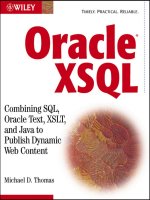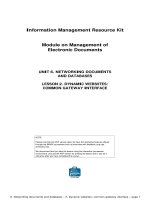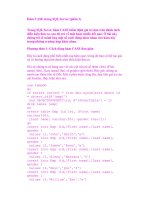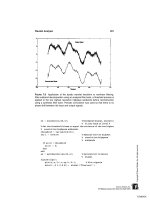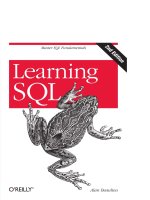Oracle XSQL combining sql oracle text xslt and java to publish dynamic web content phần 1 docx
Bạn đang xem bản rút gọn của tài liệu. Xem và tải ngay bản đầy đủ của tài liệu tại đây (1.15 MB, 60 trang )
Oracle
XSQL
Combining SQL, Oracle Text,
XSLT, and Java to Publish
Dynamic Web Content
Michael D. Thomas
Oracle
XSQL
Combining SQL, Oracle Text,
XSLT, and Java to Publish
Dynamic Web Content
Publisher: Robert Ipsen
Editor: Theresa Hudson
Developmental Editor: Kathryn A. Malm
Managing Editor: Micheline Frederick
Text Design & Composition: Wiley Composition Services
This book is printed on acid-free paper. ∞
Copyright © 2003 by Michael D. Thomas. All rights reserved.
Published by Wiley Publishing, Inc., Indianapolis, Indiana
Published simultaneously in Canada
No part of this publication may be reproduced, stored in a retrieval system, or transmitted
in any form or by any means, electronic, mechanical, photocopying, recording, scanning, or
otherwise, except as permitted under Section 107 or 108 of the 1976 United States Copyright
Act, without either the prior written permission of the Publisher, or authorization through
payment of the appropriate per-copy fee to the Copyright Clearance Center, Inc., 222 Rose-
wood Drive, Danvers, MA 01923, (978) 750-8400, fax (978) 750-4470. Requests to the Pub-
lisher for permission should be addressed to the Legal Department, Wiley Publishing, Inc.,
10475 Crosspointe Blvd., Indianapolis, IN 46256, (317) 572-3447, fax (317) 572-4447, E-mail:
Limit of Liability/Disclaimer of Warranty: While the publisher and author have used their
best efforts in preparing this book, they make no representations or warranties with respect
to the accuracy or completeness of the contents of this book and specifically disclaim any
implied warranties of merchantability or fitness for a particular purpose. No warranty may
be created or extended by sales representatives or written sales materials. The advice and
strategies contained herein may not be suitable for your situation. You should consult with
a professional where appropriate. Neither the publisher nor author shall be liable for any
loss of profit or any other commercial damages, including but not limited to special, inci-
dental, consequential, or other damages.
For general information on our other products and services please contact our Customer
Care Department within the United States at (800) 762-2974, outside the United States at
(317) 572-3993 or fax (317) 572-4002.
Trademarks: Wiley, the Wiley Pubishing logo and related trade dress are trademarks or reg-
istered trademarks of Wiley Publishing, Inc., in the United States and other countries, and
may not be used without written permission. All other trademarks are the property of their
respective owners. Wiley Publishing, Inc., is not associated with any product or vendor
mentioned in this book.
Wiley also publishes its books in a variety of electronic formats. Some content that appears
in print may not be available in electronic books.
ISBN 0-471-27120-9
Printed in the United States of America
10 9 8 7 6 5 4 3 2 1
To my wife, Aylett—your smile brightens my days.
About the Author xix
Chapter 1 Introducing Oracle XSQL 1
What XSQL Solves 2
The Problems of Web Application Development 2
XSQL as a Keystone Technology 5
XSQL and Other Oracle Technologies 11
Oracle Text 12
XML Support 12
Oracle JDeveloper 13
Introduction to XML 13
The Role of XML 13
Well-Formed versus Valid Documents 15
Document Structure 15
Processing Instructions 17
Attributes 17
Syntax Nitty-Gritty 18
Element Name and Attribute Restrictions 18
Special Characters 19
CDATA 20
Comments 20
Namespaces 21
Schemas 21
Moving On 22
Chapter 2 Getting Started with XSQL 23
Basic Installation 24
Installation Anatomy 24
Scratch XSQL Installation 26
Unix Prerequisites 26
Using Oracle Universal Installer 27
Configuring Java 29
Contents
vii
Installing in Existing Environments 30
Web and Application Server Integration 30
Servlet Engine Compatibility 30
Installing on a Servlet Engine 31
Configuring the Database 32
Configuring the Database Connection 33
Moving On 33
Chapter 3 Hello, XSQL! 35
Loading the XSQL Samples 35
Creating a Demo User and Table 37
Setting Connection Definitions 38
Your First XSQL Page 38
Your First XSLT Stylesheet 39
XSQLConfig.xml 41
XSQLConfig Element 41
Servlet Element 41
Processor Element 42
Http Element 44
Connectiondefs Element 44
Actiondefs Element 45
Serializerdefs Element 45
Security Issues 46
Known Issues 46
The XSQLConfig.xml File 46
SQL Poisoning 47
Denial-of-Service Attacks 49
An Example Security Hole 50
Thinking about XSQL Security 50
Provide Few Opportunities 51
Keep Up-to-Date 51
Always Consider Security in Application Design 51
The Multilateral Approach 52
Moving On 52
Chapter 4 XSQL Architecture 53
Overview 53
Java Parts 54
Java Virtual Machine 55
Driver 56
Servlet Engine 56
JSP Runtime 57
Faces Of XSQL 58
XSQL Command Line Utility 58
XSQLRequest Class 59
XSQL Servlet 60
XSQL Page Processor 60
viii Contents
Oracle XML Modules 63
XML Parser 63
XML SQL 64
XSLT Processor 64
Core XSQL Components 65
XSQL Pages 65
Actions 66
Action Handlers 66
Serializers 67
Moving On 68
Chapter 5 Writing XSQL Pages 69
Querying the Database 69
Multiple xsql:query Actions 73
xsql:query Details 75
xsql:no-rows-query 77
Canonical Schema 77
Formatting Dates 80
Other Built-in Actions 82
xsql:dml 82
xsql:ref-cursor-function 83
xsql:include-owa 83
xsql:include-request-params 84
xsql:include-param 85
xsql:include-xml 85
xsql:set-page-param 85
xsql:set-session-param 86
xsql:set-cookie 87
xsql:set-stylesheet-param 88
xsql:action 89
xsql:include-xsql 89
xsql:insert-request 90
xsql:update-request 91
xsql:delete-request 92
xsql:insert-param 93
Linking to XSLT Stylesheets 94
Processing Instruction Details 95
Choosing Stylesheets Based on Client Type 96
Moving On 96
Chapter 6 XSQL Parameters 97
Referencing Parameters 98
Parameter XML Representation 100
Parameter Types 102
Request Parameters 102
Page-Private Parameters 104
Session Parameters 104
Cookies 106
Contents ix
Setting Default Parameters 108
Using Bind Variables 109
Resolving Conflicting Parameter Names 110
Stylesheets and Parameters 111
Moving On 113
Chapter 7 Database Modifications with XSQL 115
Inputting HTML Forms 115
Form Parameters and the Canonical Schema 116
Using xsql:insert-request 119
Using xsql:update-request 120
Using xsql:delete-request 121
Modifying with xsql:dml 122
Handling XML Documents 123
Handling Posted XML 124
Handling XML Parameters 128
Inserting XML as XML 129
Moving On 130
Chapter 8 Oracle SQL 131
SQL Syntax 131
Case Sensitivity 131
Lexical Conventions 132
Data Types 132
String Types 133
Number Types 133
Date Types 134
Large-Object Types 134
Raw Type 136
Other Types 136
Operators 137
SQL Expressions 137
Describing Tables 139
Select Queries 139
Target Clause 140
Types of Target Objects 140
Multiple Target Objects and Joins 140
Target Aliasing 141
Subqueries as Targets 142
Elements Clause 143
Element Expressions 143
Expression Aliasing 144
Distinct Keyword 147
Where Clause 148
How the Where Clause Works 148
Comparison Operators 151
String-Matching Operators 153
x Contents
Logical Operators 153
Joins Examined 156
Order By Clause 158
Working with Sets 159
The Imaginary Dual Table 160
Managing Tables 161
Creating Tables 161
Altering Tables 164
Working with Columns 164
Dropping Tables 166
Adding and Modifying Data 167
Transactions 167
Sequences 168
Insert Statements 170
Update Statements 171
Delete and Truncate Statements 172
Views 172
Creating and Altering Views 172
Using Views 174
Constraints 175
Types of Constraints 175
Using Constraints 177
Date Formatting 178
XSQL Dates versus Oracle Dates 178
Date-Format Elements 180
SQL Functions 182
Using Aggregate Functions 183
GROUP BY Clauses 183
Aggregate Functions and DISTINCT Keyword 184
Avg 185
Count 186
Max 186
Min 187
Stddev 188
Sum 190
Variance 191
General-Purpose Numeric Functions 192
Abs 192
Bin_to_num 193
Ceil 193
Floor 193
Greatest 194
Least 194
Mod 195
Power 195
Round 196
Contents xi
Sign 196
Sqrt 197
Trunc 197
Logarithmic and Trigonometric Functions 197
Character Functions 198
Ascii 198
Bitand 199
Chr 200
Concat 200
Greatest 200
Initcap 201
Instr 201
Instrb 202
Least 203
Length 203
Lengthb 204
Lower 204
Lpad 204
Ltrim 205
Nls_initcap 205
Nls_lower 206
Nls_upper 206
Nls_sort 206
Replace 206
Rpad 207
Rtrim 207
Soundex 208
Substr 208
Substrb 209
Translate 209
Trim 210
Upper 210
Date Functions 211
Add_months 211
Current_timestamp 211
Dbtimezone 212
Extract 212
Greatest 213
Last_day 213
Least 214
Local_timestamp 214
Months_between 214
New_time 215
Next_day 215
Numtodsinterval 216
Numtoyminterval 217
Round 217
xii Contents
Sessiontimezone 218
Sys_extract_utc 218
Sysdate 218
Systimestamp 219
Trunc 219
Conversion Functions 219
Convert 221
Decompose 222
Translate 222
Unistr 222
Miscellaneous Functions 223
Moving On 224
Chapter 9 PL/SQL 225
Hello, PL/SQL! 225
Structure 228
Declaring Variables 228
Scalar Variable Declarations 229
Record Declarations 231
Cursors 232
Array Structures 232
PL/SQL Blocks and the Execution Section 234
SQL Statements in PL/SQL 235
Control Structures 237
Conditional Control Structures 237
Iterative Control Structures 239
Sequential Control Structures 240
Cursors 241
Packages 244
Procedures and Functions 245
Exceptions 247
Triggers 248
Reference Cursors 250
PL/SQL and XSQL 251
Moving On 251
Chapter 10 Using Oracle Text 253
Simple Keyword Searching 254
Stemming, Fuzzy, Wildcard, and Soundex Searching 255
Searching within XML Documents 256
Other Features 259
Moving On 259
Chapter 11 Retrieving XML 261
What’s So Hard? 261
Creating XML with
xsql:include-owa 263
Generating XML from PL/SQL 265
XMLType 267
Moving On 271
Contents xiii
Chapter 12 XSLT 273
Getting Started with XSLT 274
The Place of XSLT 274
Push and Pull 275
XHTML and Stylesheet Creation 277
XHTML Defined 278
A Simple XHTML Transformation 282
Tips and Tricks of Migrating HTML 285
Moving On 286
Chapter 13 XSLT In-Depth 287
Root Element 288
xsl:stylesheet Syntax 288
Examples 290
Controlling the Output 291
xsl:output Syntax 291
Examples 292
Templates 293
xsl:template Syntax 294
xsl:apply-templates Syntax 296
xsl:call-template 297
Examples 298
Value Selection 301
xsl:value-of Syntax 302
Examples 303
Iteration 304
xsl:for-each Syntax 305
Examples 306
Conditional Logic 307
boolean Expressions 308
xsl:if Syntax 308
xsl:choose, xsl:when, and xsl:otherwise Syntax 309
Examples 311
Working with XML Entities and Text 314
xsl:element, xsl:attribute, and
xsl:attribute-set Syntax 315
xsl:attribute Syntax 316
xsl:attribute-set Syntax 318
Element Creation Examples 318
xsl:text Syntax 320
xsl:comment Syntax 321
xsl:copy Syntax 322
xsl:copy-of Syntax 324
xsl:namespace-alias Syntax 325
xsl:processing-instruction Syntax 326
Numbering Elements 327
xsl:number 328
xsl:decimal-format Syntax 330
xiv Contents
Variables and Parameters 331
xsl:variable Syntax 331
Variable Examples 332
xsl:param Syntax 335
xsl:with-param Syntax 336
Parameter Examples 337
Reusing Stylesheets 339
xsl:include and xsl:import Syntax 340
xsl:apply-imports 340
Sorting 340
xsl:sort Syntax 340
Examples 341
Whitespace Handling 342
Miscelleneous Elements 342
xsl:key Syntax 342
xsl:message 343
xsl:fallback 343
XPath 344
Expressions and Data Types 344
Location Paths 345
Axes 346
self (.) 347
descendant-or-self (//) 348
parent ( ) 348
attribute (@) 349
child 349
descendant 350
ancestor 350
ancestor-or-self 351
following-sibling 351
preceding-sibling 352
following 352
preceding 352
namespace 352
XPath and XSLT Functions 353
XSLT Specific Functions 353
current 353
document 353
format-number 353
generate-id 354
key 354
system-property 355
unparsed-entity-uri 356
Node-Set Functions 356
count 356
id 357
last 357
Contents xv
local-name 358
Name 358
namespace-uri 358
position 358
String Functions 359
concat 359
contains 359
normalize-space 359
starts-with 359
string 360
string-length 360
Substring 361
substring-before 361
substring-after 362
translate 362
boolean Functions 363
boolean 363
false 364
lang 364
not 364
true 364
Number Functions 364
ceiling 364
floor 364
number 365
round 365
sum 365
Moving On 366
Chapter 14 Building XSQL Web Applications 367
Application Architecture 368
The Simple XSQL Architecture 369
Process for Developing Your Architecture 370
Extension Options 375
Stored Procedures 375
Action Handlers 376
Programmatic Invocation 377
Stylesheet Extensions 378
Extending the Interface with JavaScript and CSS 378
Extension at the Database Level 379
A Sample Application 380
The Requirements 380
Application Interface Design 381
Database Requirements 385
Database Design 387
Database Implementation 391
Writing the SQL 392
xvi Contents
Integrating XSQL with XSLT 397
Making the XSQL Pages 397
Writing the Stylesheets 401
Passing Parameters 415
Passing Using SQL 415
Setting Stylesheet Parameters 417
Using Other XSQL Parameters 418
Stateless Paging 421
Challenges of Pagination 422
Pure XSQL Stateless Paging 422
XSQL Data Editor 428
Editor Architecture 428
XSQL Development 430
Developing the XSQL Interface 431
Javascript and XSQL Development 435
JavaScript and XSLT Integration 435
Javascript and XSQL Data 437
Error Handling 438
XSQL Errors 439
An XSQL Error Template 440
Ways to Handle Errors 441
Moving On 442
Chapter 15 Command Line Utility 443
Using the Command Line Utility 443
Text Example 445
Script Writing 446
Creating Static Web Pages 448
Moving On 449
Chapter 16 Web Services with XSQL 451
Architecture 452
A Simple Web Services Consumer 456
XML-to-XML Transformations 461
XML Handling Actions 467
Moving On 468
Chapter 17 XSQL Beyond Web Browsing 469
A Sample Program 470
Guide to the XSQL Classes 473
Using XSQL from within Servlets 474
XML Parsing: DOM versus SAX 475
Oracle DOM API 476
Moving On 477
Chapter 18 Custom Action Handlers 479
Getting Started 479
Hello, Action Handler! 480
Adding XML to the Datagram 482
Comparing Action Handler and Servlet Development 484
Contents xvii
Action Handler APIs 485
XSQLActionHandler Interface 485
XSQLActionHandlerImpl Base Class 487
XSQLPageRequest 491
Accessing Servlet Functionality 492
Database Interaction 493
Using Built-in Action Handlers 494
JDBC Connections 500
Using the XSU classes 502
Adding XMLType Objects 503
Parameters and Input 504
Accessing XSQL Data 505
Substituting Parameter Values 507
Setting Page Parameters 510
Inter-action Handler Communication 513
Moving On 515
Chapter 19 Serializers 517
Serializer Overview 517
The Place of Serializers 518
Using Serializers 519
Creating PDFs with Apache FOP 520
FOP Architecture 520
Using the XSQL FOP serializer 522
Creating Custom Serializers 526
Text Serializers 527
Binary Serializers 530
Serializing BLOBs 534
Creating JPEGs with Java AWT 537
Moving On 546
Appendix A Resources 547
Code Examples from This Book 547
Oracle Technet 547
Oracle Database Resources 548
SQL Manual for Oracle 9i 548
PL/SQL Reference 548
Oracle XML DB 548
Oracle XML Developer’s Kit 548
XSLT Resources 549
Java Resources 549
Appendix B Related Standards 551
XSL-FO 551
Scalable Vector Graphics (SVG) 552
SQLJ and Java-Stored Procedures 552
Index 553
xviii Contents
Michael D. Thomas is a Software Engineer living in Raleigh, North Carolina. He was
lead author for one of the first books on Java, Java Programming for the Internet (Ventana,
1996). He also has a long history with XML—he wrote his own XML parser in 1997 as
part of a web services app and has used XML on numerous projects over the years. He
learned Oracle while working for the company, and has been having adventures with
it and other databases ever since. Throughout his career he has worked as both an
architect and an engineer on numerous projects using XSQL, XSLT, XML, Java, JSP,
JavaScript, PL/SQL, Oracle, and other fun technologies. In 1998, he received the
Outstanding Technical Achievement Award from IBM for his Internet integration
work using Java, HTTP, XML, and other technologies. He can be reached at
About the Author
xix
1
Welcome to the exciting world of eXtended Structured Query Language (XSQL) devel-
opment! What’s so exciting? Efficiency and ease of use. XSQL isn’t some razzle-dazzle
technology to wow your users. It also isn’t the latest X standard du jour that no one can
stop talking about—until you ask, “But what does it do for me today?” The problem
with all of the great stuff out there is that no one technology does it all. A Web server
doesn’t store all of the company’s inventory data. A database, by itself, cannot present
its data to its users in an attractive and usable manner. This is where XSQL comes in.
XSQL allows you to easily leverage the most robust, mature, and usable technologies
in the industry: Standard Query Language (SQL), HyperText Markup Language
(HTML), HyperText Transfer Protocol (HTTP), eXtensible Markup Language (XML),
Java, and the Oracle relational database management system (RDBMS).
Each of these technologies is arguably the best-of-breed in its space. When it comes
to querying relational data, SQL has no competitors. HTML and HTTP are the wonder
twins of the Internet. They have their faults, but they also have the ability to evolve.
Java has had unparalleled success in the world of enterprise applications and will con-
tinue to do so. XML is the standard for structuring data in a platform and application-
independent manner. Last but not least, the Oracle RDBMS is the technology, as well as
the market, leader in its space.
In the next few hundred pages, XSQL allows you to bring these powerful pieces
together. You’ll learn how you can use XSQL to instantly present your database data on
the Web. You’ll develop a complete application with just XSQL and eXtensible
Introducing Oracle XSQL
CHAPTER
1
Stylesheet Language Transformation (XSLT). You’ll also see how to use XSQL to create
graphics on the fly and to render Portable Document Format (PDF) documents based
on dynamic data. All the while, the easiest cases require no Java coding at all. You only
have to use Java coding for the more complex interactions with the database.
This chapter serves as a general overview to XSQL, as well as the foundation tech-
nologies. The first topic covered is an examination of what XSQL solves. This includes
some short code examples that illustrate how powerful XSQL can be. The next discus-
sion explores how XSQL relates to other Oracle technologies. You don’t have to use
XSQL exclusively with Oracle, but XSQL makes a great combination. The chapter ends
with some in-depth exploration of XML. XSQL and XSLT are derived from XML, so
you need to have a good understanding of XML before diving in.
What XSQL Solves
Before trying to learn any new technology, it is worthwhile to thoroughly understand
the problems that the technology solves. In the previous paragraphs, you were
promised that XSQL brings technologies together. In this section, you’ll see, at a high
level, how XSQL delivers on that promise. More important, however, you’ll see why
the integration of the various technologies is a problem in the first place.
The first step is to understand what the key problems are with Web application
development. The marriage of the Web with enterprise applications has its problem
spots, just like any marriage. As you’ll see, XSQL greatly simplifies a key component of
the relationship: database access. This leads to the next discussion: How does the data-
base fit into modern Web application development? As you’ll see throughout the book,
the Oracle database is great for storing not only relational information, but XML infor-
mation, also. XML, in turn, offers a lot of solutions to the fundamental problems of Web
application development. Because XSQL is fundamentally XML based, it’s important
to understand how XML provides these solutions. Always nearby XSQL is XSLT. XSLT
allows you to transform XML into . . . well, almost anything. In a world of so much
technology, the problem of transforming from one data format to another comes up
regularly. XSLT solves this problem, and will start the examination in this section. The
section ends with an examination of how XSQL bridges the gap between all of these
technologies.
The Problems of Web Application Development
This chapter is all about perspective, and nothing gives a better perspective than his-
tory. So to begin our discussion of the current state of Web application development,
it’s worthwhile to first consider the history of the Web itself. In the beginning—way
back in 1990-—there were just HTML, Uniform Resource Locators (URLs), and HTTP.
The real beauty of the system was hyperlinks. Tim Berners-Lee was proposing that you
could link documents together—get this—across a network! His paper, “Information
Management, A Proposal” from 1990 says it best:
Imagine, then, the references in this document, all being associated with the network
address of the thing to which they referred, so that while reading this document you could
skip to them with a click of the mouse.
2 Chapter 1
From this concept, the hyperlink as we know it today was born. Now, Tim Berners-
Lee wasn’t the first to conceive of a hyperlink, but he implemented his system correctly
and kept it simple enough so that it could propagate. He was also helped by a couple
of other factors. First, the timing was right. The Internet’s underlying protocol, Trans-
mission Control Protocol/Internet Protocol (TCP/IP), was well formed and widely
used by this time. Second, he invented the system in an academic setting. This is a
commonality of many of the great Internet standards. It’s easier to freely share a set
of protocols through academia than in a commercial landscape. In the early 1990s,
it was unheard of for software companies to give away complex software and designs
for free.
However, the key reason why the Web grew is that it began as a very simple system.
HTTP began as an extremely simple protocol and remains largely so to this day. You
send a request and receive a response. It’s the server’s duty to figure out how to
respond, and it’s the client’s duty to act upon the response. There were only three pos-
sible methods for asking: GET, POST, and the rarely used HEAD. This made it easy to
develop Web servers. The client only had to understand a handful of possible
responses. Likewise, HTML was designed with simplicity in mind. Instead of using the
much more powerful but much more complex SGML, Berners-Lee opted for only a
subset. Developing servers and clients was so easy, in fact, that much of the early
development of the Web was completed by developers and students working in their
spare time, or by professionals working on it as a special project. It’s telling to note that
the two institutions that did so much to give birth to the Web—the Conseil Européen
pour la Recherche Nucléaire (CERN) and the National Center for Supercomputing
Applications at the University of Illinois at Urbana-Champaign—had no research
focus on network computing at the time the Web was invented in their labs!
Because of its simplicity, the Web spread like wildfire. It spread so far that now more
than half of the American people have Web access. Most everyone who has a computer
on their desk at work has Web access. This pervasiveness makes it an ideal platform for
application development. You don’t have to worry about installing a software applica-
tion on everybody’s desktop or requiring customers to install software at home. On top
of that, you don’t have to worry about different platforms. From a logistical standpoint
alone, the Web is the obvious platform choice for many applications.
There’s only one little problem: The Web was originally intended for simple docu-
ment sharing! This causes some issues, the most obvious of which derives from the
stateless nature of the Web. HTTP originally didn’t support cookies, which allow you
to bind different HTTP transactions together into user sessions. When you are just
sharing static documents, you don’t need to tie different HTTP transactions together.
The documents always remain the same, so it doesn’t matter what documents the user
requested previously. However, when your data is dynamic, it often does matter what
requests preceded the current one. A shopping cart application is a good example of
this. When the user is ready to purchase the items, the Web application has to have
tracked what items were selected across several HTTP transactions.
There are several techniques to address this problem, not the least of which is cook-
ies. XSQL fully supports both cookies and servlet sessions. You’ll learn about these
mechanisms as the book progresses. More to the point, though: the mechanisms for
supporting sessions were added to the original HTTP after the initial design, as were
JavaScript and the concept of connecting databases to the Web. Perhaps most impor-
tant, however, is that HTML documents are inadequate for conveying information.
Introducing Oracle XSQL 3
HTML only gives instructions to a Web browser regarding how to display the infor-
mation. This is a very important function, but it means that you can’t interpret the
HTML semantically. This is where XML comes in.
It’s easy to say that the Web could have been designed better, but hindsight is
always 20/20. In truth, the Web is great because it’s so easy to extend. Though it was
originally intended for static documents, it was easy to add support for images and
dynamic data. A Web server doesn’t care what kind of information it sends or where it
came from. HTTP merely describes the mechanics of transferring the information in a
simple and lightweight manner. If the HTML document contains JavaScript, that’s
fine—it’s up to the browser to understand how to use that information.
Likewise, creating database-driven Web pages is just a burden on the server. Web
browsers don’t know the first thing about interacting with a database. Strictly speak-
ing, an HTTP server process doesn’t, either. It just knows to hand off certain URLs to
servlets and other server-side modules that interact with the database and produce
dynamic results.
This evolution continues today with Web services. HTTP is so simple that you can
easily embed simple Web clients in your code. Then, you can grab data from remote
machines and use their data in your programs. Because HTTP doesn’t care what is
sent, you can use XML to structure the data. HTTP is also very loose in what it receives,
so you can send data back to the server. Thus, a protocol originally intended to make it
easy for physicists to share documents can be used as the backbone for powerful dis-
tributed applications.
The process of developing Web applications is maturing. While early Web applica-
tion developers had to concoct solutions as they encountered a wide variety of prob-
lems, a lot of the pioneering is done. The best solutions are being recognized as such
and adopted widely. Java and Java Database Connectivity (JDBC) are good examples
of this, as are XML and XSLT.
The XSQL framework is yet another evolution in Web development. With XSQL,
producing dynamic Web pages that interact with the database is nearly as simple as
writing an HTML page itself. In the not-so-distant past, you had to write a module in a
language like Java, Perl, or C++ that managed the database connection, executed SQL
against the database, and then processed the results. That just got you started. From
there, you had to figure out what to do with the results. Because the number and type
of results could vary widely for the same module, you had to deal with issues like how
many results to put on a page and how to format different types. This model, often
called the three-layered model, is illustrated in Figure 1.1.
Figure 1.1 The three-layered model.
DatabaseClient
Presentation
Layer
Business
Logic Layer
Middle Tier
Database
Layer
4 Chapter 1
